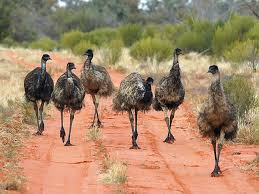Emus (pronounced ee-mews) are the second largest member of the
ratite group of flightless birds. They are the national bird of
Australia. Emus are native to Australia and were originally imported
to the United States as breeding stock for American zoos. They
have quickly grown in popularity to today's premier alternative
livestock for the American farmer.
It is believed that the emu is a survivor of prehistoric times
and dates back some 80 million years roaming the outback of Australia.
The Aborigine tribes relied upon the emu for their existence. The
emu provided them with food, clothing, shelter, and spiritual sustenance.
The emu is now playing a large role in the future of American agriculture. |
 |
Female (in front) and male
2 week
old emu chicks.
|
The expanding emu inventory in the United States
is domestically bred. As research and information sharing increase,
the American emu is emerging as the industry standard. The American
breeder market is vigorous and can be made profitable for small
and large participants.
Emus are curious and docile. They are about 10 inches tall at
birth, with black and white stripes. As 3-month-old chicks, they
turn nearly solid black, changing into a tan, brown, and black
mixture as adults, some with a bluish neck. The feathers are downy,
with no stiff vein running through the center.
The mature emu is 5 to 6 feet tall and normally weighs 90 to 120
pounds. They are flightless and strong runners, reaching ground
speeds of up to 40 miles per hour in short bursts and covering
about nine feet in stride.
Emus adapt well to temperature extremes from in excess of 100
degrees to below zero. No diseases have yet been diagnosed as common
to the species. They can exist on a simple diet and require much
water, drinking 2 to 4 gallons daily. They also will play in water
or mud.
The Emu hen can be productive for 25 to 35 years or more and may
lay 20 to 50 eggs in a season. A hen may lay as early as 18 months,
but normally laying begins at 2 to 3 years old.
Pairs normally breed from October to April, usually producing
one egg every three days. Incubation time is 48 - 52 days and the
percentage of eggs hatched is approximately 70 - 80%. Chick survival
rates are excellent. Emus are very hardy.
The emerald green egg, which normally
hatches in about 48 to 52 days, produces a chick that will walk
within hours and run within days. The chicks achieve rapid growth,
gaining their height by one year of age. After six months, the
birds have shed most of their chick feathers for the fluffy, elegant
feathers of the adult. For most climate conditions, the birds need
shelter during the first few months, although the birds are very
hardy and adaptable.
For today's U.S. farmer/rancher/homesteader, emu farming offers
an alternative cash crop. With minimal investment in facilities
and land area, excellent feed conversion ratio, and an established
worldwide market evolving, the emu will provide a stable cash return
to its owners now and in the years to come.
The
Egg - An Art Form All its Own
|
The color of the eggs range from a medium green to a dark green (almost
black) with some having a very smooth glasslike texture.
An average egg
weigh between 600 and 700 grams when laid.
The eggs are edible consisting
of approximately 10 chicken eggs. The egg is mostly yolk but has a
much milder flavor than other poultry. It
is excellent
when used in cooking.
Unfertile eggs are blown for crafters. Engraving is possible as
the outer layer of shell is green, the next layer is a light blue
and the inside layer is white. This is demonstrated in this picture
below |
 |
|
| Eggs can also be used in an art form known as filigree. This is
where a pattern is cut entirely thru the shell. Makes a nice nightlight. |
 |
|
| These
eggs can be used to make jewelry boxes, can be painted or even have
decals applied. | | | | | | | | | | | | | | | | | | | | | | |
|
|
  

|
|
|





No comments:
Post a Comment